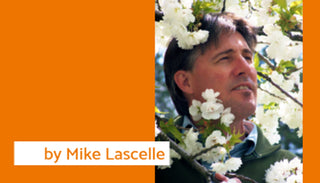
A recent Okanagan vacation reminded me that a lot has changed since I used to spend summers at my Grandma’s Westbank home back in the 1970s. Gone are the freestanding apple orchards, all replaced with thin cordon types supported on wires to a height of about 7-8’ tall, where they can be hand-picked without ladders. It makes perfect sense as far as commercial production is concerned but that doesn’t mean that you can’t have one or two old-fashioned apples growing in your backyard for fresh eating, canning, or even making delicious pies. So, here is everything you need to know about choosing the right ones.
Location…Location…Location
Apples need a minimum of 6-8 hours of sun a day in summer, with more being better. They will tolerate a lightly acidic pH but prefer fertile soils that are moist and well-drained. Sandy soils can be amended with compost or Sea Soil and wet areas should be avoided altogether.
How Many Apple Trees Can I Plant?
That depends on the rootstock used, with the more common M26 producing trees that average 10-12’ tall and wide, while the more compact M9 or M27 trees usually reach only 6-8’ tall and wide, but require permanent support. You will want to leave at least 6’ between mature trees to allow for good air circulation and sun penetration. People living on smaller lots can consider columnade forms such as ‘Golden Sentinel’ and ‘Scarlet Sentinel’ which will mature at 8-9’ tall and 2-3’ wide when planted in-ground. Another option would be tiered espalier apples which are meant to grow flat against a south or west-facing fence or wall.
What If I can Only Plant One Apple Tree?
Then you are going to have to choose a self-fertile variety such as ‘Spartan’, ‘Gala’, ‘Golden Delicious’, ‘Cortland’ (which also pollinates ‘Elstar’ and ‘Cox’s Orange’), or even a crabapple, like ‘Dolgo’. Another good option is a multigraft tree with 3-5 different varieties – these can come in both espalier and free-standing forms.
Do Other Apples Require Pollination?

Most apple cultivars are not self-fertile and require the pollen from a different variety that blooms at the same time. Apples can be considered early, mid-season, or late bloomers, so make sure your apples flower during the same season to allow for cross-pollination.
There are also some varieties called triploids which have three sets of chromosomes and are technically sterile, meaning that they require pollination from another apple but provide no viable pollen themselves. These include cultivars such as ‘Bramley’s Seedling’, ‘Belle de Boskoop’, ‘Gravenstein’, ‘Jonagold’, and ‘King’.
Cultivating mason bees also greatly helps with production, as these often emerge just as the apple blossoms open and they are very effective pollinators.

Are There Disease-Resistant Apples?
No apple variety is impervious to disease but there are some cultivars that fare a little better in our wet coastal climate, including ‘Redfree’, ‘Liberty’, ‘Prima’, ‘Freedom’, and ‘Florina’.
Which Apple Trees Can I Grow In A Container?
Any of the columnade-type apples such as ‘Golden Sentinel’, ‘Scarlet Sentinel’, ‘Treasured Red’, ‘North Pole’, ‘Urban Tasty Treat’, and ‘Urban Tangy Green’ can be grown in a container, although availability is limited. Your other option is to grow a self-fertile variety such as ‘Gala’ or ‘Spartan’ on M9 or M27 rootstock in a large half-barrel, but again support will be required once it starts bearing.
How Long Will It Take My Apple Trees to Produce Fruit?
Most nursery-sold apples begin bearing in their second or third year after planting. You may have to thin the fruit on young trees, as the young branches often produce more apples than they can bear.
You should also familiarize yourself with apple spurs (see image), or the fruiting shoots that form on the sides and tips of branches. I once had a customer who asked me why his eight-year-old apple wasn’t producing fruit even though he pruned out all of the little stubs and tips every late winter. Unfortunately, he was also removing all of his fruiting spurs.
When and How Do I Prune My Apple Trees?
Mature apples require both a dormant and summer prune. Dormant pruning is generally done in late winter and focuses on the removal of dead or diseased wood, light heading to keep the crown in form, and clearing away crossed branches or those that impede air and light circulation. Summer pruning occurs midsummer and is focussed on the removal or heading of new growth or maiden laterals. This is particularly important when dealing with tiered espaliers, as the branches from lower tiers must not be allowed to cross over the upper ones.


For more information about how to prune espalier apple trees, check out this video.
What About Apple Tree Pests & Diseases?

Your biggest concern will probably be apple scab, a common fungal problem when we have prolonged, wet springs. Pick up your fallen leaves in autumn and send them to the municipal compost. Also, be sure to spray (lime sulfur/dormant oil) your trees after your dormant pruning. Apple maggots can be a localised problem, too, and can be partially controlled by hanging apple maggot traps, a plastic sphere resembling an apple coated in a sticky paste and often fitted with a lure.

These pests are active from June to September and the traps are meant to capture the females before they lay eggs under the skin of apples, which results in the maggots doing the damage. It is also very important to pick up any fallen infected fruit and send it to the municipal compost in order to break the life cycle as the pupae overwinter in the soil.
Is It Really Worth Growing My Own Apples?
One bite of your first homegrown apple should answer that question handily…definitely, yes!


